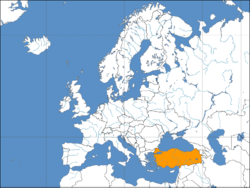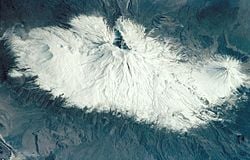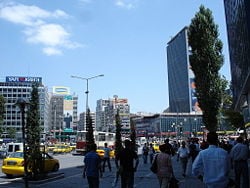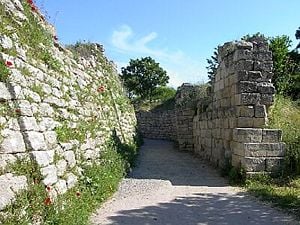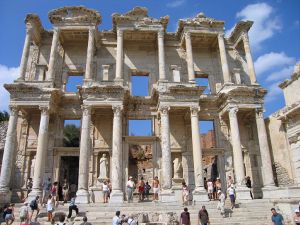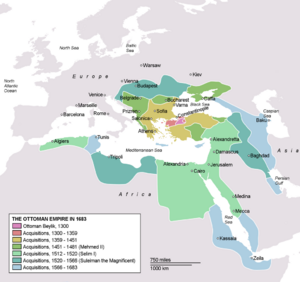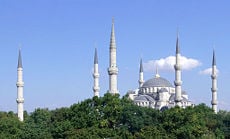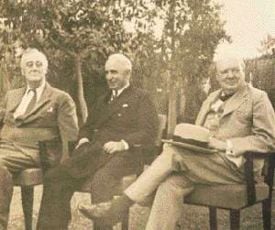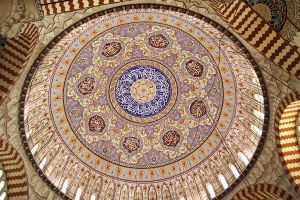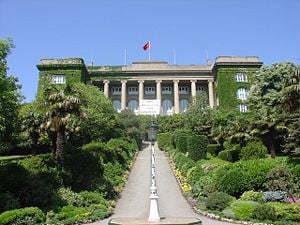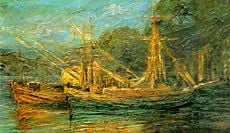Difference between revisions of "Turkey" - New World Encyclopedia
Mike Butler (talk | contribs) m |
Mike Butler (talk | contribs) m |
||
| Line 76: | Line 76: | ||
==Etymology== | ==Etymology== | ||
| − | |||
The name for Turkey in the [[Turkish language]], ''Türkiye'', can be divided into two words: ''Türk'', which means "strong" in [[Old Turkic language|Old Turkic]] and usually signifying the inhabitants of Turkey or a member of the [[Turkish people|Turkish]] or [[Turkic peoples|Turkic]] peoples, a later form of ''"tu-kin"'', name given by the [[Chinese people|Chinese]] to the people living south of the [[Altay Mountains]] of [[Central Asia]] as early as 177 B.C.E.; and the [[Arabic grammar#Nisba|abstract suffix]] ''-iye'', which means "owner" or "related to". | The name for Turkey in the [[Turkish language]], ''Türkiye'', can be divided into two words: ''Türk'', which means "strong" in [[Old Turkic language|Old Turkic]] and usually signifying the inhabitants of Turkey or a member of the [[Turkish people|Turkish]] or [[Turkic peoples|Turkic]] peoples, a later form of ''"tu-kin"'', name given by the [[Chinese people|Chinese]] to the people living south of the [[Altay Mountains]] of [[Central Asia]] as early as 177 B.C.E.; and the [[Arabic grammar#Nisba|abstract suffix]] ''-iye'', which means "owner" or "related to". | ||
| Line 208: | Line 207: | ||
==Demographics== | ==Demographics== | ||
| − | + | [[Image:413252 4345.jpg|thumb|left|300px|[[İstiklal Avenue]] and the tram line running between [[Taksim Square|Taksim]] and [[Tünel]]]] | |
| − | [[Image:413252 4345.jpg|thumb|left|[[İstiklal Avenue]] and the tram line running between [[Taksim Square|Taksim]] and [[Tünel]]]] | + | As of 2005, the population of Turkey stood at 72.6 million with a growth rate of 1.5 percent yearly. An estimated 67 percent of Turkey's population live in urban centers. The Turkish population is relatively young, with 25.5 percent falling within the 0-15 age bracket. Life expectancy in 2005 stood at 68.9 years for men and 73.8 years for women, for an overall average of 71.3 years for the populace as a whole. |
| − | As of 2005, the population of Turkey stood at 72.6 million with a growth rate of 1.5 | ||
| − | [[ | + | Due to a demand for an increased labour force in post-World War II Europe, many Turkish citizens emigrated to [[Western Europe]] (particularly [[West Germany]]), contributing to the creation of a significant diaspora. Recently, Turkey has also become a destination for numerous immigrants, especially since the fall of the Berlin Wall and the consequent increase of freedom of movement in the region. These immigrants generally migrate from the former Soviet Bloc countries, as well as neighbouring Muslim states, either to settle and work in Turkey or to continue their journey towards the European Union. |
| − | + | ===Ethnicity=== | |
| − | + | [[Image:TurkishPeople.jpg|400px|thumb|right| Top: Mehmed II, Suleiman the Magnificent, Mustafa Kemal Atatürk, Sabiha Gökçen, Pekinel sisters. Bottom: Cahit Arf, Nazım Hikmet, İdil Biret, Oktay Sinanoğlu, and Şebnem Ferah.]] | |
| − | [[ | + | The Ottoman Empire welcomed perhaps millions, of Spanish and Portuguese Jews after 1492, Russian schismatics in seventeenth and eighteenth centuries, [[Nekrasov Cossacks]], Polish and Hungarian revolutionaries after 1848, Jews escaping the pogroms and later the Shoah, White Russians fleeing the [[Bolshevik Revolution]] in 1917, Russian and other socialist or communist revolutionaries, Trotskyists fleeing the U.S.S.R. in the 1930s. |
| − | + | Since 1923, Turkey has welcomed Muslim refugees, like [[Crimean Tatars]], [[Circassians]] and [[Chechens]] from the Russian Empire, Algerian followers of Abd-el-Kader, Mahdists from Sudan, Turkmens, Kazakhs, Kirghizs and other Central Asian Turkic-speaking peoples fleeing the U.S.S.R. and later the war-torn Afghanistan, Balkan Muslims, either Turkish-speaking or [[Bosniaks]], [[Pomaks]], [[Albanians]], and Greek Muslims, fleeing either the new Christian states or later the Communist regimes, in Yugoslavia and Bulgaria for instance. | |
| − | [[ | + | Article 66 of the Turkish Constitution defines a "Turk" as anyone that is "bound to the Turkish state through the bond of citizenship". Therefore, the legal use of the term "Turkish" as a citizen of Turkey is different from the ethnic definition. However, the majority of the Turkish population are of [[Turkish ethnicity]]. Other major ethnic groups include the [[Kurds]], [[Circassians]], [[Roma]], [[Arabs]] and the three officially-recognized minorities of [[Greeks]], [[Armenians]] and [[Jews]]. The largest non-Turkic ethnicity is the [[Kurds]], a distinct ethnic group traditionally concentrated in the southeast of the country. Minorities other than the three official ones do not have any special group privileges, and while the term "minority" itself remains a sensitive issue in Turkey, it is to be noted that the degree of assimilation within various ethnic groups outside the recognized minorities is high, with the following generations adding to the [[melting pot]] of the Turkish main body. Within that main body, certain distinctions based on diverse [[Turkic]] origins could be made as well. Reliable data on the exact ethnic repartition of the population is not available, as the Turkish census figures do not include ethnic or racial figures. |
| − | [[Turkish | + | ===Religion=== |
| + | [[Image:Selimiye Mosque, Dome.jpg|thumb|right|300px|Interior of the [[Selimiye Mosque]], [[Edirne]]]] | ||
| + | Nominally, 99 percent of the Turkish population is [[Islam|Muslim]], of whom a majority belong to the [[Sunni Islam|Sunni]] branch of Islam. A sizeable minority of the population is affiliated with the [[Alevi]] sect. The mainstream [[Hanafi|Hanafite]] school of [[Sunni Islam]] is largely organised by the state, through the ''[[Diyanet İşleri Başkanlığı]]'' (Religious Affairs Directorate), which controls all mosques and Muslim clerics. The remainder of the population belongs to other beliefs, particularly [[Christianity|Christian]] denominations ([[Greek Orthodox]], [[Armenian Apostolic]], [[Syriac Orthodox]]), [[Judaism]], [[Yezidism]] and [[Atheism]]. | ||
| − | + | There is a strong tradition of secularism in Turkey. Even though the state has no official religion nor promotes any, it actively monitors the area between the religions. The constitution recognises freedom of religion for individuals, whereas religious communities are placed under the protection of the state; but the constitution explicitly states that they cannot become involved in the political process (by forming a religious party, for instance) or establish faith-based schools. No party can claim that it represents a form of religious belief; nevertheless, religious sensibilities are generally represented through conservative parties. Turkey prohibits by law the wearing of [[Hijab|religious headcover]] and theo-political symbolic garments for both genders in government buildings, schools, and universities; the law was upheld by the Grand Chamber of the [[European Court of Human Rights]] as "legitimate" in ''[[Leyla Şahin v. Turkey]]'' on November 10, 2005. | |
| − | |||
| − | + | === Language === | |
| − | + | [[Image:Orkhon tablet 8th century.jpg|right|thumb|200px|Tablets of the Orkhon Inscriptions of eighth century, in which "Turk" was first used by the Göktürks.]] | |
| + | [[Turkish language|Turkish]] is the sole [[official language]] throughout Turkey. Reliable figures for the linguistic repartition of the populace are not available. The [[Turkish language]] is a member of the [[Oghuz Turks|Oghuz]] subdivision of [[Turkic languages]], which in turn is a branch of the proposed [[Altaic languages|Altaic language]] family. Turkish is for the most part, mutually intelligible with other Oghuz languages like [[Azeri]], [[Crimean Tatar]], [[Gagauz]], [[Turkmen]] and [[Urum]], and to a lesser extent with other Turkic languages. | ||
| + | |||
| + | Modern Turkish differs greatly from the Ottoman Turkish language, the administrative and literary language of the Ottoman Empire, which was influenced heavily by Arabic and Persian. During the Ottoman period, the language was essentially a mixture of Turkish, Persian, and Arabic, differing considerably from the everyday language spoken by the empire's Turkish subjects, to the point that they had to hire ''arzıhâlcis'' (request-writers) to communicate with the state. After the proclamation of the [[Turkish Republic]], many of the foreign borrowings in the language were replaced with Turkic equivalents in a language reform] by the newly founded Turkish Language Association. Almost all government documents and literature from the Ottoman period and the early years of the Republic are thus unintelligible to today's Turkish-speaker without translation. | ||
| + | |||
| + | Historically, there were many dialects of Turkish that were spoken throughout [[Anatolia]] and the [[Balkans]] that differed significantly from each other. After the proclamation of the Republic, the [[Istanbul]] dialect was adopted as the standard. There is no official effort to protect regional dialects, and some are currently under threat of disappearing as they face the standard language used in the media and educational system. | ||
| + | |||
| + | Nevertheless, the public broadcaster [[Turkish Radio and Television Corporation|TRT]] broadcasts programmes in local languages and dialects of [[Arabic language|Arabic]], [[Bosnian language|Bosnian]], [[Circassian language|Circassian]] and [[Kurdish language|Kurdish]] a few hours a week. | ||
| + | |||
| + | ===Men and women=== | ||
| + | Turkish law guarantees equal pay for equal work and has opened most educational programs and occupations to women. Men tend to dominate the high-status occupations in business, the military, government, the professions, and academia. Traditionally, women do domestic work and should not work in public or with unrelated men. | ||
| + | |||
| + | ===Marriage and the family=== | ||
| + | [[Image:Istanbul Cicek Pasaji - Cité de Pera.jpg|thumb|right|300px|[[Çiçek Pasajı]] (''Flower Passage'' - also known by its French name ''Cité de Péra'') is one of the many historic buildings that adorn Istiklal Avenue]] | ||
| + | In traditional Turkish society, kin groups controlled the selection of spouses and the marriage ceremony. In 1926, the revolutionary Turkish government abolished Islamic family law and adopted a modified version of the family law in the Swiss civil code, which recognizes civil marriage ceremonies only, and prescribes monogamy. Most marriages occur with the couple's consent, but families still play a role recommending and screening potential spouses, especially for their daughters. Divorce occurs infrequently. The law recognizes six grounds for divorce: adultery; plot against life, grave assaults, and insults; crime or a dishonorable life; desertion; mental infirmity; and incompatibility. Establishing one of these grounds has proved difficult, and a couple cannot divorce by mutual consent. | ||
| + | |||
| + | Although most households comprise one nuclear family, the ideal household, especially among the rural and urban wealthy, is an extended family, in which a son and his bride lived in his parents' home after marriage. The next kinship units is the “sulale,” consisting of relatives connected by a common male ancestor. While kin groups are important to old, noble Ottoman families and tribal peoples, it is of little significance to most Turks. | ||
| + | |||
| + | The father or oldest male is the head of the family, who demands respect and obedience. The mother is respected, but her relationship with her children is warm and informal. Women are responsible for the home, and men are responsible for providing the income and representing the household to the outside world. Before the 1960s, even grocery shopping was a male duty. The new Family Law grants women equal rights to private property and inheritance. | ||
| + | |||
| + | Boys are taught to be courageous, assertive, proud, and respectful of elders. When they are circumcised between ages nine and 12, they are told to be as brave as lions. Girls are taught to be modest, compliant, to support males, to be virtuous, and skilled in domestic tasks. | ||
| + | |||
| + | ===Education=== | ||
| + | [[Image:AFL-garden.jpg|thumbnail|300px|right|[[Ankara Science High School]] in [[Ankara]]]] | ||
| + | [[Education in Turkey|Education]] is compulsory and free from ages 6 to 15. | ||
| + | When children become six years old, they might attend kindergartens (public or private). | ||
| + | The elementary school provides eight years of education for children between the ages of seven and 15. In primary school, basic information, Turkish language, mathematics, sciences, social sciences, art, music, physical education, handicraft, English language, and sometimes another foreign language (generally French or German) are taught. There are two types of elementary schools, public (governmental) and private. | ||
| + | |||
| + | At the end of eighth grade, students take an exam, [[OKS]], which lasts for two hours and is composed of about 100 questions. It tests the students' skills in Turkish, mathematics, natural and social sciences learned through the elementary school. According to their scores, they are placed to different kinds of high schools. | ||
| + | |||
| + | The high school lasts four years, with some high schools having an additional one year of English preparatory classes. The different kinds of high schools of the Turkish education system include: ''Public High Schools'', the standard type; ''Anatolian High Schools'' which provide additional skills in a selected foreign language (English, German or French) by instructing a certain part of science courses in the foreign language; ''science high schools'' focusing on science education; ''vocational high schools'', which focus on a certain type of profession, like tourism, industry, and electrical work in addition to the standard lesson outline; ''Imam-Hatip high schools'', which serve the purpose of educating imams for performing religious duties at mosques; and finally, ''private high schools'', which are established by private enterprises. Almost all private high schools give education in English (some lessons are in English) and teach a second foreign language. | ||
| + | |||
| + | [[Image:RobertCollegeGouldHall1.jpg|thumb|300px|[[Robert College]] of Istanbul]] | ||
| + | |||
| + | When students complete the 10th grade, they choose tracks leading to certain specializations. There four tracks are: ''Turkish-Math'', ''Science'', ''Social Sciences'' and ''Languages''. In ''Vocational High Schools'' no tracks are offered, in ''Science High Schools'' only the ''Science'' tracks is offered. There are presumed professions to be acquired by the students after completing a certain track. | ||
| + | |||
| + | *''Turkish-Math'' track professions are: [[International Relations]], [[Law]], [[Education]], [[Psychology]], [[Economy]], [[Business Management]], and the like. | ||
| + | *''Science'' track professons are: [[Engineering]], [[Computer Science]], [[Medicine]], and other [[Science]] related professions. | ||
| + | *''Social Sciences'' track professions are: [[History]], [[Geography]], and [[Education]]. | ||
| + | *''Languages'' track professions are: All [[Language]] / [[Linguistics]] related professions. | ||
| + | |||
| + | At the end of high school, following the 12th grade, students take a ''High School Finishing Examination'' and they are required to pass this in order to take the [[ÖSS]] and continue their studies at a university. | ||
| + | |||
| + | [[Image:Bosphorus_University.jpg|thumbnail|300px|right|The former [[Robert College]] building on South Campus of [[Bosphorus University|Boğaziçi Üniversitesi]], [[Istanbul]]]] | ||
| + | [[Image:MiddleEastTechnicalUniversity2003SpringFestival800x560.jpg|thumb|right|250px|Students of [[Middle East Technical University]], [[Ankara]]]] | ||
| + | |||
| + | Universities provide either two or four years of education for undergraduate studies whereas for graduate studies, a further two years is necessary, as is typical throughout the world. There are around 820 higher education institutions including universities with a total student enrolment of over one million. | ||
| + | |||
| + | The literacy rate is 95.3 percent for men and 79.6 percent for women, for an overall average of 87.4 percent. This low figure is mainly due to prevailing feudal attitudes against women in the Arab- and Kurdish-inhabited south-eastern provinces of the country. | ||
| + | |||
| + | ===Class=== | ||
| + | Wealth and education determine social status are. Turkey has the wealthy urban educated class, the urban middle class, the urban lower class, the large rural landowner class, and the general rural population. A university education is the minimum qualification for entry into the urban educated class, in which there are numerous substrata. Most members of the urban upper class speak at least one Western language, are familiar with European or American life and culture, and are connected to the diplomatic and foreign business communities. | ||
| + | The urban lower class includes semiskilled and unskilled laborers, low-paid service workers, and the urban unemployed. The high rate of migration of young villagers to urban areas makes this the most rapidly growing class. About 30 percent of the population are rural farmers, often referred to as peasants. | ||
==Culture== | ==Culture== | ||
Revision as of 21:36, 27 May 2007
| Türkiye Cumhuriyeti Republic of Turkey | |||||
| |||||
| Motto: none (Unofficial: "Yurtta Barış, Dünyada Barış"1 "Peace at Home, Peace in the World") | |||||
| Anthem: İstiklâl Marşı Independence March | |||||
| Capital | Ankara 39°55'48.00′N 32°50′E | ||||
|---|---|---|---|---|---|
| Largest city | Istanbul | ||||
| Official languages | Turkish | ||||
| Government | Parliamentary republic | ||||
| - President | Ahmet Necdet Sezer | ||||
| - Prime Minister | Recep Tayyip Erdoğan | ||||
| Succession | to the Ottoman Empire2 | ||||
| - War of Independence | May 19 1919 | ||||
| - Formation of Parliament | April 23 1920 | ||||
| - Declaration of Republic | October 29 1923 | ||||
| Area | |||||
| - Total | 783,562 km² (37th) 302,535 sq mi | ||||
| - Water (%) | 1.3 | ||||
| Population | |||||
| - 2007 estimate | 71,158,647 | ||||
| - 2000 census | 67,803,927 | ||||
| - Density | 93/km² 240/sq mi | ||||
| GDP (PPP) | 2006 estimate | ||||
| - Total | $612.3 billion | ||||
| - Per capita | $9,107 | ||||
| HDI (2006) | 0.7574 (medium) | ||||
| Currency | New Turkish Lira5 (TRY)
| ||||
| Time zone | EET (UTC+2) | ||||
| - Summer (DST) | EEST (UTC+3) | ||||
| Internet TLD | .tr | ||||
| Calling code | +90 | ||||
Turkey, known officially as the Republic of Turkey (Türkiye Cumhuriyeti ▶), is a Eurasian country that stretches across the Anatolian peninsula in southwest Asia and the Balkan region of southeastern Europe.
Turkey also contains the Sea of Marmara, which is used by geographers to mark the border between Europe and Asia, thus making Turkey transcontinental.
The region comprising modern Turkey has overseen the birth of major civilizations such as the Byzantine and Ottoman Empires. Because of its strategic location, where two continents meet, Turkey's culture has a unique blend of Eastern and Western tradition, often described as a bridge between the two civilizations.
Etymology
The name for Turkey in the Turkish language, Türkiye, can be divided into two words: Türk, which means "strong" in Old Turkic and usually signifying the inhabitants of Turkey or a member of the Turkish or Turkic peoples, a later form of "tu-kin", name given by the Chinese to the people living south of the Altay Mountains of Central Asia as early as 177 B.C.E.; and the abstract suffix -iye, which means "owner" or "related to".
The first recorded use of the term "Türk" or "Türük" as an autonym is contained in the Orkhon inscriptions of the Göktürks (Sky Turks) of Central Asia (c. 8th century CE). The English word "Turkey" is derived from the Medieval Latin "Turchia" (c. 1369).
Geography
Turkey borders eight countries: Bulgaria to the northwest, Greece to the west, Georgia to the northeast, Armenia, Azerbaijan (the Nakhichevan exclave), and Iran to the east, Iraq and Syria to the southeast. It borders the Mediterranean Sea to the south, the Aegean Sea to the west, and the Black Sea to the north.
Turkey's area, including lakes, occupies 300,948 square miles (779,452 square kilometres) of which 291,773 square miles (755,688 square kilometers) are in Southwest Asia and 9174 square miles (23,764 square kilometers) in Europe. Turkey's size makes it the world's 37th-largest country (after Mozambique). It is somewhat bigger than Chile or the U.S. state of Texas.
The European section of Turkey, in the northwest, is Eastern Thrace, and forms the borders of Turkey with Greece and Bulgaria. The Asian part of the country, Anatolia (also called Asia Minor), consists of a high central plateau with narrow coastal plains, in between the Köroğlu and East-Black Sea mountain range to the north and the Taurus Mountains to the south.
Eastern Turkey has a more mountainous landscape, and is home to the sources of rivers such as the Euphrates, Tigris and Aras, and contains Lake Van and Mount Ararat, Turkey's highest point, at 16,946 feet (5165 meters).
Turkey is geographically divided into seven regions: Marmara, Aegean, Black Sea, Central Anatolia, Eastern Anatolia, Southeastern Anatolia and the Mediterranean. The uneven north Anatolian terrain running along the Black Sea resembles a long, narrow belt. This region comprises approximately one-sixth of Turkey's total land area. As a general trend, the inland Anatolian plateau becomes increasingly rugged as it progresses eastward.
Turkey's varied landscapes are the product of complex earth movements that have shaped the region over thousands of years and still manifest themselves in fairly frequent earthquakes and occasional volcanic eruptions. The Bosporus and the Dardanelles owe their existence to the fault lines running through Turkey that led to the creation of the Black Sea. There is an earthquake fault line across the north of the country from west to east.
Turkey has a Mediterranean temperate climate, with hot, dry summers and mild, wet and cold winters, though conditions can be much harsher in the more arid interior. Mountains close to the coast prevent Mediterranean influences from extending inland, giving the interior of Turkey a continental climate with distinct seasons. The central Anatolian Plateau is much more subject to extremes than coastal areas. Winters on the plateau are especially severe. Temperatures of minus 22°F to minus 40°F (minus 30°C to minus 40°C) can occur in the mountainous areas in the east, and snow may lie on the ground 120 days of the year. In the west, winter temperatures average below 34°F (1°C). Summers are hot and dry, with temperatures generally above 86°F (30°C) in the day.
Annual precipitation averages about 15 inches (400mm) with actual amounts determined by elevation. The driest regions are the Konya plain and the Malatya plain, where annual rainfall frequently is less than 12 inches (300mm) May is generally the wettest month, whereas July and August are the most dry.
Natural hazards include very severe earthquakes, especially in northern Turkey, along an arc extending from the Sea of Marmara to Lake Van. On August 17, 1999, a 7.4-magnitude earthquake struck north-western Turkey, killing more than 17,000 and injuring 44,000.
Current environmental issues concern water pollution from dumping of chemicals and detergents, air pollution, particularly in urban areas, deforestation, and concern for oil spills from increasing Bosphorus ship traffic.
Ankara is the capital of Turkey and the country's second largest city after İstanbul. The city had a population of 4,319,167 in 2005. Centrally located in Anatolia, Ankara is an important commercial and industrial city. It is the center of the Turkish Government, and houses all foreign embassies. It is an important crossroads of trade, strategically located at the center of Turkey's highway and railway networks, and serves as the marketing center for the surrounding agricultural area. However, İstanbul is the financial, economic and cultural heart of the country. Other important cities include İzmir, Bursa, Adana, Trabzon, Malatya, Gaziantep, Erzurum, Kayseri, İzmit, Konya, Mersin, Eskişehir, Diyarbakır, Antalya and Samsun. In all, 12 cities have populations that exceed 500,000, and 48 cities have more than 100,000 inhabitants.
History
The Anatolian peninsula (also called Asia Minor), comprising most of modern Turkey, is one of the oldest continually inhabited regions in the world due to its location at the intersection of Asia and Europe. The earliest Neolithic settlements such as Çatalhöyük (Pottery Neolithic dating from around 7500 B.C.E.), and Çayönü (Pre-Pottery Neolithic A to Pottery Neolithic, from 7200 B.C.E. til 6600 B.C.E.), are considered to be among the earliest human settlements in the world.
The settlement of Troy starts in the Neolithic and continues into the Iron Age. Through recorded history, Anatolians have spoken Indo-European, Semitic and South Caucasian languages, as well as many languages of uncertain affiliation. In fact, given the antiquity of the Indo-European Hittite and Luwian languages, some scholars have proposed Anatolia as the hypothetical center from which the Indo-European languages have radiated.
Hittites
The first major empire in the area was that of the Hittites, from the eighteenth through the thirteenth century B.C.E. Subsequently, the Phrygians, an Indo-European people, achieved ascendancy until their kingdom was destroyed by the Cimmerians in the seventh century B.C.E. The most powerful of Phrygia's successor states were Lydia, Caria and Lycia. The Lydians and Lycians spoke languages that were fundamentally Indo-European, but both languages had acquired non-Indo-European elements prior to the Hittite and Hellenic periods.
The west coast of Anatolia was meanwhile settled by the Ionians, one of the ancient Greek peoples. The entire area was conquered by the Persian Achaemenid Empire during the sixth and fifth centuries and later fell to Alexander the Great in 334 B.C.E. Anatolia was subsequently divided into a number of small Hellenistic kingdoms (including Bithynia, Cappadocia, Pergamum, and Pontus), all of which had succumbed to Rome by the mid-1st century B.C.E.
In 324 C.E., the Roman emperor Constantine I chose Byzantium to be the new capital of the Roman Empire, renaming it New Rome (later Constantinople and Istanbul). After the fall of the Western Roman Empire, it became the capital of the Byzantine Empire (Eastern Roman Empire).
Ottoman Empire
The House of Seljuk was a branch of the Kinik Oghuz Turks who in the ninth century resided on the periphery of the Muslim world, north of the Caspian and Aral Seas in the Yabghu Khaganate of the Oğuz confederacy. In the tenth century, the Seljuks migrated from their ancestral homelands into the eastern Anatolian regions that had been an area of settlement for Oğuz Turkic tribes.
Following their victory over the Byzantine Empire in the Battle of Manzikert in 1071, the Turks began to abandon their nomadic roots in favour of a permanent role in Anatolia, bringing rise to the Seljuk Empire. In 1243, the Seljuk armies were defeated by the Mongols and the power of the empire slowly disintegrated. In its wake, one of the Turkish principalities governed by Osman I was to evolve into the Ottoman Empire, thus filling the void left by the collapsed Seljuks and Byzantines.
The Ottoman Empire interacted with both Eastern and Western cultures throughout its 623-year history. In the sixteenth and seventeenth centuries, it was among the world's most powerful political entities, often locking horns with the powers of eastern Europe in its steady advance through the Balkans and the southern part of the Polish-Lithuanian Commonwealth. Following years of decline, the Ottoman Empire entered World War I through the Ottoman-German Alliance in 1914, and was ultimately defeated. After the war, the victorious Allied Powers sought the dismemberment of the Ottoman state through the Treaty of Sèvres.
Republic
The occupation of İstanbul and İzmir by the Allies in the aftermath of World War I prompted the establishment of the Turkish national movement. Under the leadership of Mustafa Kemal Atatürk Pasha, a military commander who had distinguished himself during the Battle of Gallipoli, the Turkish War of Independence was waged with the aim of revoking the terms of the Treaty of Sèvres. By September 18, 1922, the occupying armies were repelled and the country saw the birth of the new Turkish state. On November 1, the Grand National Assembly of Turkey formally abolished the Sultanate, thus ending 623 years of Ottoman rule. The Treaty of Lausanne of 1923 led to the international recognition of the sovereignty of the newly formed "Republic of Turkey" as the successor state of the Ottoman Empire, and the republic was officially proclaimed on October 29, 1923, in the new capital of Ankara.
Mustafa Kemal became the republic's first president and subsequently introduced many radical reforms with the aim of founding a new secular republic from the remnants of its Ottoman past. According to the Law on Family Names, the Turkish parliament presented Mustafa Kemal with the honorific name "Atatürk" (Father of the Turks) in 1934.
World War II
Turkey entered World War II on the side of the Allies on February 23, 1945 as a ceremonial gesture and became a charter member of the United Nations in 1945. Difficulties faced by Greece after the war in quelling a communist rebellion, along with demands by the Soviet Union which wanted to establish military bases in the Turkish Straits, prompted the United States to declare the Truman Doctrine in 1947. The doctrine enunciated American intentions to guarantee the security of Turkey and Greece, and resulted in large-scale US military and economic support.
After participating with United Nations forces in the Korean War, Turkey joined the North Atlantic Treaty Organization (NATO) in 1952, becoming a bulwark against Soviet expansion into the Mediterranean. Following a decade of violence on the island of Cyprus and the subsequent Athens-inspired coup, Turkey intervened militarily in 1974. Nine years later Turkish Republic of Northern Cyprus (TRNC) was established. TRNC is recognised only by Turkey.
Instability
Following the end of the single-party period in 1945, the multi-party period witnessed tensions over the following decades, and the period between the 1960s and the 1980s was particularly marked by periods of political instability that resulted in a number of military coups d'états in 1960, 1971, 1980, and a post-modern coup d'état in 1997. The liberalization of the Turkish economy that started in the 1980s changed the landscape of the country, with successive periods of high growth and crises punctuating the following decades.
Government and politics
Turkey is a republican parliamentary democracy. Since its foundation as a republic in 1923, Turkey has developed a strong tradition of secularism. Turkey's constitution governs the legal framework of the country. It sets out the main principles of government and establishes Turkey as a unitary centralized state.
The president, who is the chief of state and who has a largely ceremonial role, is elected by the National Assembly for a single seven-year term. The president appoints the prime minister, who is generally the head of the party that has won the elections, and has been elected by the parliament through a vote of confidence. The prime minister in 2007 was the former mayor of İstanbul, Recep Tayyip Erdoğan, whose Islamic conservative Justice and Development Party (Turkey) won an absolute majority of parliamentary seats in the 2002 general elections, organized in the aftermath of the economic crisis of 2001, with 34 percent of the suffrage. The cabinet is a council of ministers appointed by the president on the nomination of the prime minister. Executive power is exercised by the Prime Minister and the Council of Ministers that make up the government.
Legislative power is vested in the unicameral Grand National Assembly of Turkey or Turkiye Buyuk Millet Meclisi. Its 550 members are elected by popular vote by a party-list proportional representation system from 85 electoral districts to serve five-year terms. Elections were last held in November 2002. To avoid excessive political fragmentation, only parties that win at least 10 percent of the votes cast gain the right to representation in the parliament. Every Turkish citizen who has turned 18 years of age has the right to vote.
The judiciary is independent of the executive and the legislature. The Constitutional Court rules on the conformity of laws and decrees with the constitution. The Council of State is the tribunal of last resort for administrative cases, and the High Court of Appeals for all others. Turkey abandoned Islamic law and adopted the Italian penal code in 1926. Compared to other Middle Eastern countries, the rate of ordinary crime is low. People are incarcerated for illegal political activity and thought crimes, such as advocating an Islamic state or cultural rights for an ethnic minority. Turkey is a member of the European Court of Human Rights.
The military has traditionally been a politically powerful institution, considered as the guardians of Atatürk's Republic. The protection of the Turkish Constitution and the unity of the country is given by law to the Turkish Armed Forces, and it therefore plays a formal political role via the National Security Council (NSC) as the guardian of the secular, unitary nature of the republic and the reforms of Atatürk.
Foreign relations
Turkey's main political, economic and military relations have remained rooted within the West since the foundation of the republic and its membership to NATO in 1952. Ankara became a crucial strategic ally in diverting Soviet forces from Central Europe and preventing their expansion into the Mediterranean. Though primarily a Western orientated actor in international affairs, Turkey also fostered relations with the Middle East, becoming the only NATO member of the Organization of the Islamic Conference, as well as forging close relations with Israel.
The European Union remains Turkey's biggest trading partner, and the presence of a well-established Turkish diaspora in Europe has contributed to the development of extensive relations between the two over the years. Turkey became a member of the Council of Europe in 1949, applied for associate membership of the EEC (predecessor of the EU) in 1959 and became an associate member in 1963. After decades of political negotiations, Turkey applied for full membership of the EEC in 1987, reached a Customs Union agreement with the EU in 1995 and has officially begun accession negotiations on October 3, 2005.
The long divided island of Cyprus and the disputes over the air and sea boundaries of the Aegean Sea remain the main issues of disagreement between Turkey and Greece.
Since the end of the Cold War, Turkey has been actively building relations with former communist countries in Eastern Europe and Central Asia. However, Turkey's relations with neighbouring Armenia are still tense due to the ongoing stalemate in Nagorno-Karabakh between Armenia and Azerbaijan, a Turkic-speaking neighbour and ally of Turkey, and also due to the controversy surrounding the Armenian Genocide, in which actions by the Ottoman Young Turks led to the forced mass evacuation and related deaths of an estimated hundreds of thousands, up to 1.5 million, Armenian people.
Even though Turkey participated in the NATO-led War in Afghanistan (2001–present) after September 11, 2001 attacks, the Iraq War faced strong domestic opposition in Turkey. A government motion which would have allowed U.S. troops to attack Iraq from Turkey's southeastern border couldn't reach the absolute majority of 276 votes needed for its adoption in the Turkish Parliament, the final tally being 264 votes for and 250 against. This led to a cooling in relations between the U.S. and Turkey.
Military
The Turkish Armed Forces consists of the Army, the Navy and the Air Force. The Gendarmerie and the Coast Guard operate as parts of the Ministry of Internal Affairs in peacetime, although they are subordinated to the Army and Navy Commands respectively in wartime, during which they have both internal law enforcement and military functions.
The Chief of the General Staff is appointed by the president, and is responsible to the prime minister. The council of ministers is responsible to the parliament for matters of national security and the adequate preparation of the armed forces to defend the country.
The Turkish Armed Forces is the second largest standing armed force in NATO, after the U.S. Armed Forces, with a combined strength of 1,043,550 uniformed personnel serving in its five branches. Every fit heterosexual male Turkish citizen is required to serve in the military for time periods ranging from three weeks to 15 months, depending on his education and job location (homosexuals have the right to be exempt, if they so request).
In 1998, Turkey announced a program of modernization worth some US$31-billion over a 10 year period in various projects including tanks, helicopters and assault rifles. Turkey is also a Level 3 contributor to the Joint Strike Fighter (JSF) program, gaining an opportunity to develop and influence the creation of the next generation fighter spearheaded by the United States.
Administrative divisions
The territory of Turkey is subdivided into 81 provinces for administrative purposes. The provinces are organized into seven regions for census purposes; however, they do not represent an administrative structure. Each province is divided into districts, for a total of 923 districts. Provinces usually bear the same name as their provincial capitals, also called the central district. Provinces with the largest populations are İstanbul (over 10 million), Ankara (over four million), İzmir (over 3.4 million), Konya (over 2.2 million), Bursa (over 2.1 million) and Adana (over1.85 million).
Economy
For most of its history as a republic, Turkey has adhered to a quasi-statist approach, with strict government controls over private sector participation, foreign trade, and foreign direct investment. However, during the 1980s, Turkey began a series of reforms designed to shift the economy to a more private sector, market-based model. The reforms spurred rapid growth, but this growth was punctuated by sharp recessions and financial crises in 1994, 1999 (following the earthquake of that year), and 2001, resulting in an average of 4 percent GDP growth per annum between 1981 and 2003.
The GDP growth rate for 2005 was 7.4 percent, thus making Turkey one of the fastest growing economies in the world. Turkey's GDP ranks 17th in the world, and Turkey is a member of G20 industrial nations which brings together the 20 largest economies of the globe. Turkey's economy is no longer dominated by traditional agricultural activities in the rural areas, but more so by a highly dynamic industrial complex in the major cities, mostly concentrated in the western provinces of the country, along with a developed services sector.
The agricultural sector accounts for 11.9 percent of GDP. Turkey ranks seventh worldwide and first within the Muslim world in farm output, and has been self-sufficient in food production since the 1980s. The agricultural output has been growing at a respectable rate. However, since the 1980s agriculture has been in a state of decline in comparison to the total economy.
The industrial and service sectors make up 23.7 percent and 64.5 percent, respectively. Turkey ranks 21st worldwide and third within the Muslim world in factory output. Its industrial sector has 19 percent share in employment, 29 percent share in national production, and 94 percent share in total exports. The largest industry is textiles and clothing (16.3% of total industrial capacity in 2005 according to the State Institute of Statistics), followed by oil refining (14.5%).
The tourism sector has experienced rapid growth in the last 20 years, and constitutes an important part of the economy. In 2005, there were 24,124,501 visitors to the country, who contributed 18.2 billion USD to Turkey's revenues. Other key sectors of the Turkish economy are construction, automotive industry, electronics and textiles.
Chronically high inflation was brought under control and this has led to the launch of a new currency to cement the economic reforms and erase the vestiges of an unstable economy. On January 1, 2005, the Turkish Lira was replaced by the New Turkish Lira by dropping off six zeroes (1 YTL= 1,000,000 TL). As a result of continuing economic reforms, the inflation has dropped to 8.2 percent in 2005, and the unemployment rate to 10.3 percent.
Exports totalled $85.21-billion in 2006. Export commodities included apparel, foodstuffs, textiles, metal manufactures, and transport equipment. Export partners included Germany 12.9 percent, UK 8.1 percent, Italy 7.6 percent, US 6.7 percent, France 5.2 percent, and Spain 4.1 percent.
Imports totalled $120.9-billion in 2006. Import commodities included machinery, chemicals, semi-finished goods, fuels, and transport equipment. Import partners included Germany 11.7 percent, Russia 11 percent, Italy 6.5 percent, China 5.9 percent, France 5 percent, US 4.6 percent, and UK 4 percent.
Per capita GDP was $9107 in 2006, or 69th on a list of 181 nations. The unemployment rate was 10.2 percent in 2006. Twenty percent existed below the poverty line in 2002.
Demographics
As of 2005, the population of Turkey stood at 72.6 million with a growth rate of 1.5 percent yearly. An estimated 67 percent of Turkey's population live in urban centers. The Turkish population is relatively young, with 25.5 percent falling within the 0-15 age bracket. Life expectancy in 2005 stood at 68.9 years for men and 73.8 years for women, for an overall average of 71.3 years for the populace as a whole.
Due to a demand for an increased labour force in post-World War II Europe, many Turkish citizens emigrated to Western Europe (particularly West Germany), contributing to the creation of a significant diaspora. Recently, Turkey has also become a destination for numerous immigrants, especially since the fall of the Berlin Wall and the consequent increase of freedom of movement in the region. These immigrants generally migrate from the former Soviet Bloc countries, as well as neighbouring Muslim states, either to settle and work in Turkey or to continue their journey towards the European Union.
Ethnicity
The Ottoman Empire welcomed perhaps millions, of Spanish and Portuguese Jews after 1492, Russian schismatics in seventeenth and eighteenth centuries, Nekrasov Cossacks, Polish and Hungarian revolutionaries after 1848, Jews escaping the pogroms and later the Shoah, White Russians fleeing the Bolshevik Revolution in 1917, Russian and other socialist or communist revolutionaries, Trotskyists fleeing the U.S.S.R. in the 1930s.
Since 1923, Turkey has welcomed Muslim refugees, like Crimean Tatars, Circassians and Chechens from the Russian Empire, Algerian followers of Abd-el-Kader, Mahdists from Sudan, Turkmens, Kazakhs, Kirghizs and other Central Asian Turkic-speaking peoples fleeing the U.S.S.R. and later the war-torn Afghanistan, Balkan Muslims, either Turkish-speaking or Bosniaks, Pomaks, Albanians, and Greek Muslims, fleeing either the new Christian states or later the Communist regimes, in Yugoslavia and Bulgaria for instance.
Article 66 of the Turkish Constitution defines a "Turk" as anyone that is "bound to the Turkish state through the bond of citizenship". Therefore, the legal use of the term "Turkish" as a citizen of Turkey is different from the ethnic definition. However, the majority of the Turkish population are of Turkish ethnicity. Other major ethnic groups include the Kurds, Circassians, Roma, Arabs and the three officially-recognized minorities of Greeks, Armenians and Jews. The largest non-Turkic ethnicity is the Kurds, a distinct ethnic group traditionally concentrated in the southeast of the country. Minorities other than the three official ones do not have any special group privileges, and while the term "minority" itself remains a sensitive issue in Turkey, it is to be noted that the degree of assimilation within various ethnic groups outside the recognized minorities is high, with the following generations adding to the melting pot of the Turkish main body. Within that main body, certain distinctions based on diverse Turkic origins could be made as well. Reliable data on the exact ethnic repartition of the population is not available, as the Turkish census figures do not include ethnic or racial figures.
Religion
Nominally, 99 percent of the Turkish population is Muslim, of whom a majority belong to the Sunni branch of Islam. A sizeable minority of the population is affiliated with the Alevi sect. The mainstream Hanafite school of Sunni Islam is largely organised by the state, through the Diyanet İşleri Başkanlığı (Religious Affairs Directorate), which controls all mosques and Muslim clerics. The remainder of the population belongs to other beliefs, particularly Christian denominations (Greek Orthodox, Armenian Apostolic, Syriac Orthodox), Judaism, Yezidism and Atheism.
There is a strong tradition of secularism in Turkey. Even though the state has no official religion nor promotes any, it actively monitors the area between the religions. The constitution recognises freedom of religion for individuals, whereas religious communities are placed under the protection of the state; but the constitution explicitly states that they cannot become involved in the political process (by forming a religious party, for instance) or establish faith-based schools. No party can claim that it represents a form of religious belief; nevertheless, religious sensibilities are generally represented through conservative parties. Turkey prohibits by law the wearing of religious headcover and theo-political symbolic garments for both genders in government buildings, schools, and universities; the law was upheld by the Grand Chamber of the European Court of Human Rights as "legitimate" in Leyla Şahin v. Turkey on November 10, 2005.
Language
Turkish is the sole official language throughout Turkey. Reliable figures for the linguistic repartition of the populace are not available. The Turkish language is a member of the Oghuz subdivision of Turkic languages, which in turn is a branch of the proposed Altaic language family. Turkish is for the most part, mutually intelligible with other Oghuz languages like Azeri, Crimean Tatar, Gagauz, Turkmen and Urum, and to a lesser extent with other Turkic languages.
Modern Turkish differs greatly from the Ottoman Turkish language, the administrative and literary language of the Ottoman Empire, which was influenced heavily by Arabic and Persian. During the Ottoman period, the language was essentially a mixture of Turkish, Persian, and Arabic, differing considerably from the everyday language spoken by the empire's Turkish subjects, to the point that they had to hire arzıhâlcis (request-writers) to communicate with the state. After the proclamation of the Turkish Republic, many of the foreign borrowings in the language were replaced with Turkic equivalents in a language reform] by the newly founded Turkish Language Association. Almost all government documents and literature from the Ottoman period and the early years of the Republic are thus unintelligible to today's Turkish-speaker without translation.
Historically, there were many dialects of Turkish that were spoken throughout Anatolia and the Balkans that differed significantly from each other. After the proclamation of the Republic, the Istanbul dialect was adopted as the standard. There is no official effort to protect regional dialects, and some are currently under threat of disappearing as they face the standard language used in the media and educational system.
Nevertheless, the public broadcaster TRT broadcasts programmes in local languages and dialects of Arabic, Bosnian, Circassian and Kurdish a few hours a week.
Men and women
Turkish law guarantees equal pay for equal work and has opened most educational programs and occupations to women. Men tend to dominate the high-status occupations in business, the military, government, the professions, and academia. Traditionally, women do domestic work and should not work in public or with unrelated men.
Marriage and the family
In traditional Turkish society, kin groups controlled the selection of spouses and the marriage ceremony. In 1926, the revolutionary Turkish government abolished Islamic family law and adopted a modified version of the family law in the Swiss civil code, which recognizes civil marriage ceremonies only, and prescribes monogamy. Most marriages occur with the couple's consent, but families still play a role recommending and screening potential spouses, especially for their daughters. Divorce occurs infrequently. The law recognizes six grounds for divorce: adultery; plot against life, grave assaults, and insults; crime or a dishonorable life; desertion; mental infirmity; and incompatibility. Establishing one of these grounds has proved difficult, and a couple cannot divorce by mutual consent.
Although most households comprise one nuclear family, the ideal household, especially among the rural and urban wealthy, is an extended family, in which a son and his bride lived in his parents' home after marriage. The next kinship units is the “sulale,” consisting of relatives connected by a common male ancestor. While kin groups are important to old, noble Ottoman families and tribal peoples, it is of little significance to most Turks.
The father or oldest male is the head of the family, who demands respect and obedience. The mother is respected, but her relationship with her children is warm and informal. Women are responsible for the home, and men are responsible for providing the income and representing the household to the outside world. Before the 1960s, even grocery shopping was a male duty. The new Family Law grants women equal rights to private property and inheritance.
Boys are taught to be courageous, assertive, proud, and respectful of elders. When they are circumcised between ages nine and 12, they are told to be as brave as lions. Girls are taught to be modest, compliant, to support males, to be virtuous, and skilled in domestic tasks.
Education
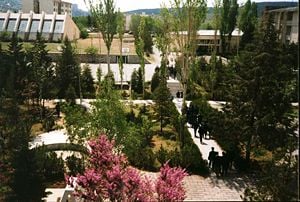
Education is compulsory and free from ages 6 to 15. When children become six years old, they might attend kindergartens (public or private). The elementary school provides eight years of education for children between the ages of seven and 15. In primary school, basic information, Turkish language, mathematics, sciences, social sciences, art, music, physical education, handicraft, English language, and sometimes another foreign language (generally French or German) are taught. There are two types of elementary schools, public (governmental) and private.
At the end of eighth grade, students take an exam, OKS, which lasts for two hours and is composed of about 100 questions. It tests the students' skills in Turkish, mathematics, natural and social sciences learned through the elementary school. According to their scores, they are placed to different kinds of high schools.
The high school lasts four years, with some high schools having an additional one year of English preparatory classes. The different kinds of high schools of the Turkish education system include: Public High Schools, the standard type; Anatolian High Schools which provide additional skills in a selected foreign language (English, German or French) by instructing a certain part of science courses in the foreign language; science high schools focusing on science education; vocational high schools, which focus on a certain type of profession, like tourism, industry, and electrical work in addition to the standard lesson outline; Imam-Hatip high schools, which serve the purpose of educating imams for performing religious duties at mosques; and finally, private high schools, which are established by private enterprises. Almost all private high schools give education in English (some lessons are in English) and teach a second foreign language.
When students complete the 10th grade, they choose tracks leading to certain specializations. There four tracks are: Turkish-Math, Science, Social Sciences and Languages. In Vocational High Schools no tracks are offered, in Science High Schools only the Science tracks is offered. There are presumed professions to be acquired by the students after completing a certain track.
- Turkish-Math track professions are: International Relations, Law, Education, Psychology, Economy, Business Management, and the like.
- Science track professons are: Engineering, Computer Science, Medicine, and other Science related professions.
- Social Sciences track professions are: History, Geography, and Education.
- Languages track professions are: All Language / Linguistics related professions.
At the end of high school, following the 12th grade, students take a High School Finishing Examination and they are required to pass this in order to take the ÖSS and continue their studies at a university.
Universities provide either two or four years of education for undergraduate studies whereas for graduate studies, a further two years is necessary, as is typical throughout the world. There are around 820 higher education institutions including universities with a total student enrolment of over one million.
The literacy rate is 95.3 percent for men and 79.6 percent for women, for an overall average of 87.4 percent. This low figure is mainly due to prevailing feudal attitudes against women in the Arab- and Kurdish-inhabited south-eastern provinces of the country.
Class
Wealth and education determine social status are. Turkey has the wealthy urban educated class, the urban middle class, the urban lower class, the large rural landowner class, and the general rural population. A university education is the minimum qualification for entry into the urban educated class, in which there are numerous substrata. Most members of the urban upper class speak at least one Western language, are familiar with European or American life and culture, and are connected to the diplomatic and foreign business communities. The urban lower class includes semiskilled and unskilled laborers, low-paid service workers, and the urban unemployed. The high rate of migration of young villagers to urban areas makes this the most rapidly growing class. About 30 percent of the population are rural farmers, often referred to as peasants.
Culture
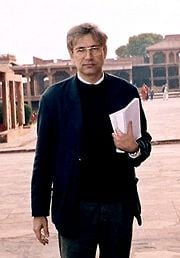
Turkey has a very diverse culture that is a blend of various elements of the Oğuz Turkic and Anatolian, Ottoman (which was itself a continuation of both Greco-Roman and Islamic cultures), and Western culture and traditions which started with the Westernization of the Ottoman Empire and continues today. This mix is a result of the encounter of Turks and their culture with those of the peoples who were in their path during their migration from Central Asia to the West.[1][2] As Turkey successfully transformed from the religion-based former Ottoman Empire into a modern nation-state with a very strong separation of state and religion, an increase in the methods of artistic expression followed. During the first years of the republic, the government invested a large amount of resources into the fine arts, such as museums, theatres, and architecture. Because of different historical factors playing an important role in defining the modern Turkish identity, Turkish culture is a product of efforts to be "modern" and Western, combined with the necessity felt to maintain traditional religious and historical values.[1]
Turkish music and literature form great examples of such a mix of cultural influences. Many schools of music are popular throughout Turkey, from "arabesque" to hip-hop genres, as a result of the interaction between the Ottoman Empire and the Islamic world along with Europe, and thus contributing to a blend of Central Asian Turkic, Islamic and European traditions in modern-day Turkish music.[3] Turkish literature was heavily influenced by Arabic and, especially, Persian literature during most of the Ottoman era, though towards the end of the Ottoman Empire the effect of both Turkish folk and Western literary traditions became increasingly felt. The mix of cultural influences is dramatized, for example, in the form of the "new symbols [of] the clash and interlacing of cultures" enacted in the work of Orhan Pamuk, winner of the 2006 Nobel Prize in Literature.[4]
Architectural elements found in Turkey are also testaments to the unique mix of traditions that have influenced the region over the centuries. In addition to the traditional Byzantine elements present in numerous parts of Turkey, many artifacts of the later Ottoman architecture, with its exquisite blend of local and Islamic traditions, are to be found throughout the country, as well as in many former territories of the Ottoman Empire. Since the 18th century, Turkish architecture has been increasingly influenced by Western styles, and this can be particularly seen in Istanbul where buildings like the Blue Mosque and the Dolmabahçe Palace are juxtaposed next to numerous modern skyscrapers, all of them representing different traditions.[5]
The most popular sport in Turkey by far is football, with certain professional and national matches drawing tens of millions of viewers on television.[6] Nevertheless, other sports such as basketball and motor sports (following the inclusion of İstanbul Park on the Formula 1 racing calendar) have also become popular recently. The traditional Turkish national sport has been the Yağlı güreş (Oiled Wrestling) since Ottoman times.[7]
See also
| |||||||||||||||||||||||||||||||||||
Notes
- ↑ 1.0 1.1 Kaya, Ibrahim (2003). Social Theory and Later Modernities: The Turkish Experience. Liverpool University Press. ISBN 0-8532-3898-7.
- ↑ Royal Academy of Arts (2005). Turks - A Journey of a Thousand Years: 600 - 1600. Royal Academy of Arts. Retrieved 2006-12-12.
- ↑ Çinuçen Tanrıkorur. The Ottoman music. www.turkmusikisi.com. Retrieved 2006-12-12.
- ↑ "Pamuk wins Nobel Literature prize", British Broadcasting Corporation, 2006-10-12. Retrieved 2006-12-12.
- ↑ Goodwin, Godfrey (2003). A History of Ottoman Architecture. Thames & Hudson. ISBN 0-5002-7429-0.
- ↑ Burak Sansal (2006). Sports in Turkey. allaboutturkey.com. Retrieved 2006-12-13.
- ↑ Burak Sansal (2006). Oiled Wrestling. allaboutturkey.com. Retrieved 2006-12-13.
ReferencesISBN links support NWE through referral fees
|
|
Further reading
- Mango, Andrew (2004). The Turks Today. Overlook. ISBN 1-5856-7615-2.
- Pope, Hugh and Pope, Nicole (2004). Turkey Unveiled. Overlook. ISBN 1-5856-7581-4.
External links
Government
- Presidency of the Republic
- The Grand National Assembly
- The Prime Minister's Office
- Ministry of Foreign Affairs
- Ministry of Interior Affairs
- Turkish Armed Forces
- Ministry of Defense
- Ministry of Culture and Tourism
Public institutions
- Directorate General of Press and Information
- Turkish Statistical Institute
- Central Bank
- Treasury
- Competition Authority
- Undersecretariat of Customs
- National Intelligence Organisation
- State Planning Organisation
- Turkish Standards Institution
- The Scientific and Technological Research Council
Additional profiles
Credits
New World Encyclopedia writers and editors rewrote and completed the Wikipedia article in accordance with New World Encyclopedia standards. This article abides by terms of the Creative Commons CC-by-sa 3.0 License (CC-by-sa), which may be used and disseminated with proper attribution. Credit is due under the terms of this license that can reference both the New World Encyclopedia contributors and the selfless volunteer contributors of the Wikimedia Foundation. To cite this article click here for a list of acceptable citing formats.The history of earlier contributions by wikipedians is accessible to researchers here:
The history of this article since it was imported to New World Encyclopedia:
Note: Some restrictions may apply to use of individual images which are separately licensed.

